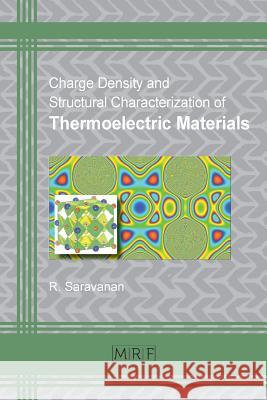Charge Density and Structural Characterization of Thermoelectric Materials » książka
Charge Density and Structural Characterization of Thermoelectric Materials
ISBN-13: 9781945291005 / Angielski / Miękka / 2016 / 184 str.
Thermoelectric materials permit the direct conversion of temperature differences into electric energy, and vice versa. They are therefore of highest technological interest in applications such as solid state coolers, waste heat recovery, sensors and detectors, and power generators including remote power generation.
Thermoelectric materials are often called "environmentally green," and for good reasons. Not only can they help generate electrical energy from waste gases as they are generated in such processes as home heating, industrial fabrication and automotive motion. In cooling applications they eliminate the use of chemical refrigerant gases. Moreover, as thermoelectric conversion devices have no moving parts, they operate silently and have a very long life expectancy. The only current drawback of these devices is their poor efficiency.
Scientists all over the world are therefore studying the structural, thermoelectric, charge-density and magnetic properties of the most promising types of these materials at the atomic and electronic level. In addition to providing an introduction to the field, the main objective of this book is to present the results of the growth and structural characterization of thermoelectric materials that are of high current interest; including Mg2Si, PbTe, Bi1-xSbx, Bi2Te3, Sb2Te3, Sn1-xGexTe and InSb.
Thermoelectric materials permit the direct conversion of temperature differences into electric energy, and vice versa. They are therefore of highest technological interest in applications such as solid state coolers, waste heat recovery, sensors and detectors, and power generators including remote power generation.
Thermoelectric materials are often called “environmentally green”, and for good reasons. Not only can they help generate electrical energy from waste gases as they are generated in such processes as home heating, industrial fabrication and automotive motion. In cooling applications they eliminate the use of chemical refrigerant gases. Moreover, as thermoelectric conversion devices have no moving parts, they operate silently and have a very long life expectancy. The only current drawback of these devices is their poor efficiency.
Scientists all over the world are therefore studying the structural, thermoelectric, charge-density and magnetic properties of the most promising types of these materials at the atomic and electronic level. In addition to providing an introduction to the field, the main objective of this book is to present the results of the growth and structural characterization of thermoelectric materials that are of high current interest; including Mg2Si, PbTe, Bi1-xSbx, Bi2Te3, Sb2Te3, Sn1-xGexTe and InSb.











